2008 FORD TAURUS X towing
[x] Cancel search: towingPage 2 of 352

Locks and Security 131
Keys 131
Locks 132
Anti-theft system 147
Seating and Safety Restraints 152
Seating 152
Safety restraints 166
Airbags 180
Child restraints 194
Tires, Wheels and Loading 209
Tire information 211
Tire inflation 213
Tire Pressure Monitoring System (TPMS) 227
Vehicle loading 231
Trailer towing 237
Recreational towing 239
Driving 241
Starting 241
Brakes 246
Traction Control™ 250
Transmission operation 252
Roadside Emergencies 264
Getting roadside assistance 264
Hazard flasher switch 265
Fuel pump shut-off switch 266
Fuses and relays 266
Changing tires 273
Lug nut torque 280
Jump starting 281
Wrecker towing 286
Table of Contents
2
2008 Taurus X(219)
Owners Guide (post-2002-fmt)
USA(fus)
Page 5 of 352

SAFETY AND ENVIRONMENT PROTECTION
Warning symbols in this guide
How can you reduce the risk of personal injury to yourself or others? In
this guide, answers to such questions are contained in comments
highlighted by the warning triangle symbol. These comments should be
read and observed.
Warning symbols on your vehicle
When you see this symbol, it is
imperative that you consult the
relevant section of this guide before
touching or attempting adjustment
of any kind.
Protecting the environment
We must all play our part in
protecting the environment. Correct
vehicle usage and the authorized
disposal of waste, cleaning and
lubrication materials are significant
steps towards this aim. Information in this respect is highlighted in this
guide with the tree symbol.
BREAKING-IN YOUR VEHICLE
Your vehicle does not need an extensive break-in. Try not to drive
continuously at the same speed for the first 1,000 miles (1,600 km) of
new vehicle operation. Vary your speed frequently in order to give the
moving parts a chance to break in.
Drive your new vehicle at least 500 miles (800 km) before towing a
trailer. For more detailed information about towing a trailer, refer to
Trailer towingin theTires, Wheels and Loadingchapter.
Do not add friction modifier compounds or special break-in oils since
these additives may prevent piston ring seating. SeeEngine oilin the
Maintenance and Specificationschapter for more information on oil
usage.
SPECIAL NOTICES
New Vehicle Limited Warranty
For a detailed description of what is covered and what is not covered by
your vehicle’s New Vehicle Limited Warranty, refer to theWarranty
Guidethat is provided to you along with yourOwner’s Guide.
2008 Taurus X(219)
Owners Guide (post-2002-fmt)
USA(fus)
Introduction
5
Page 164 of 352
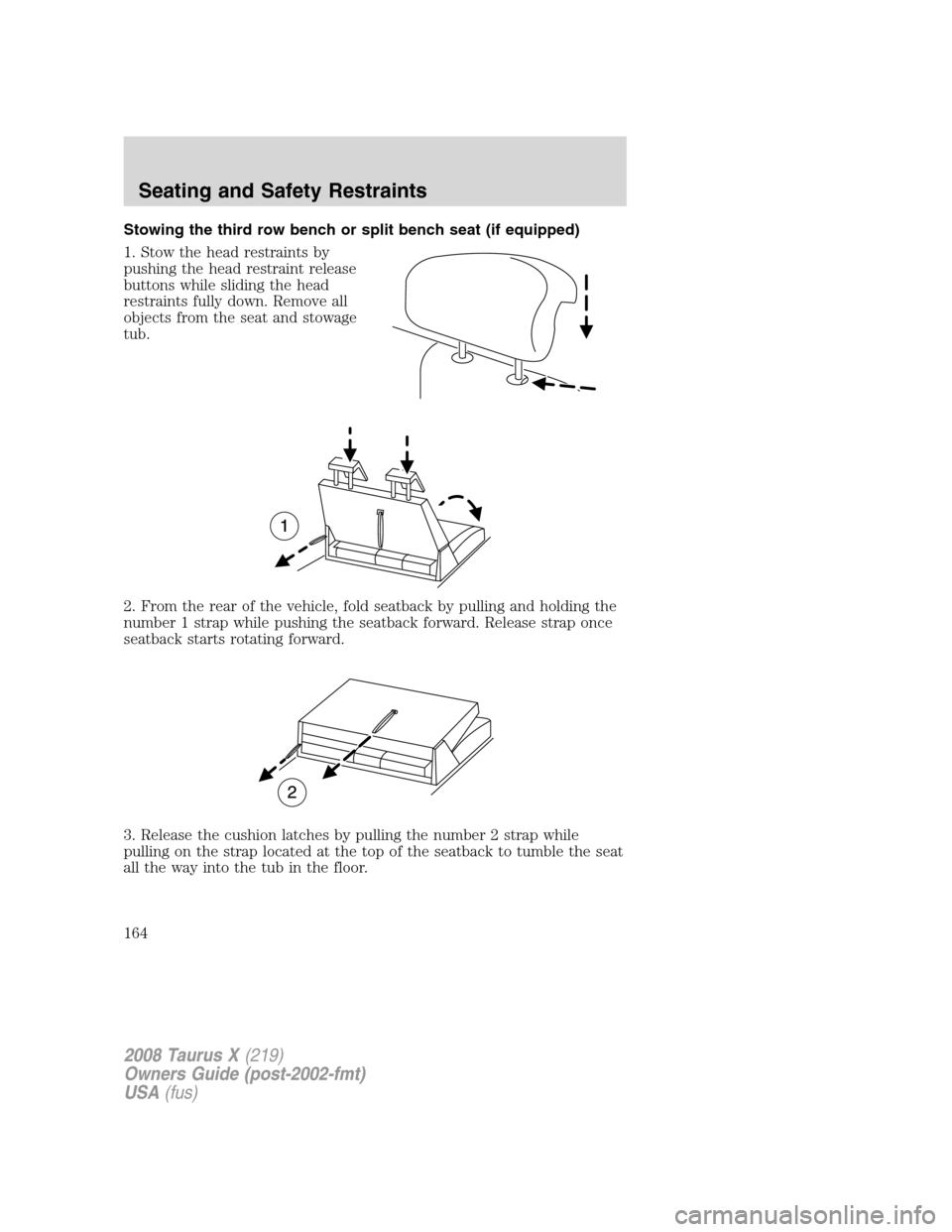
Stowing the third row bench or split bench seat (if equipped)
1. Stow the head restraints by
pushing the head restraint release
buttons while sliding the head
restraints fully down. Remove all
objects from the seat and stowage
tub.
2. From the rear of the vehicle, fold seatback by pulling and holding the
number 1 strap while pushing the seatback forward. Release strap once
seatback starts rotating forward.
3. Release the cushion latches by pulling the number 2 strap while
pulling on the strap located at the top of the seatback to tumble the seat
all the way into the tub in the floor.
2008 Taurus X(219)
Owners Guide (post-2002-fmt)
USA(fus)
Seating and Safety Restraints
164
Page 165 of 352
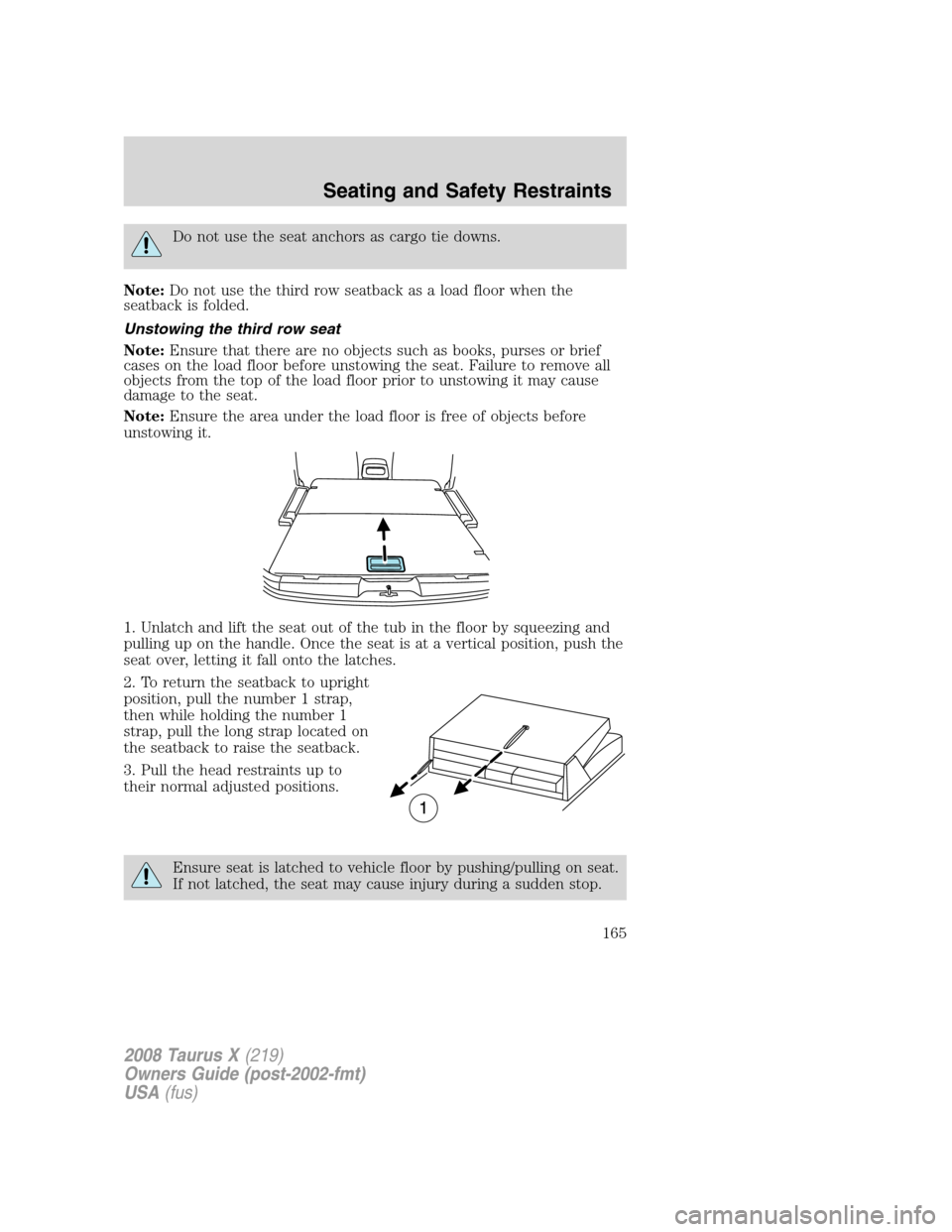
Do not use the seat anchors as cargo tie downs.
Note:Do not use the third row seatback as a load floor when the
seatback is folded.
Unstowing the third row seat
Note:Ensure that there are no objects such as books, purses or brief
cases on the load floor before unstowing the seat. Failure to remove all
objects from the top of the load floor prior to unstowing it may cause
damage to the seat.
Note:Ensure the area under the load floor is free of objects before
unstowing it.
1. Unlatch and lift the seat out of the tub in the floor by squeezing and
pulling up on the handle. Once the seat is at a vertical position, push the
seat over, letting it fall onto the latches.
2. To return the seatback to upright
position, pull the number 1 strap,
then while holding the number 1
strap, pull the long strap located on
the seatback to raise the seatback.
3. Pull the head restraints up to
their normal adjusted positions.
Ensure seat is latched to vehicle floor by pushing/pulling on seat.
If not latched, the seat may cause injury during a sudden stop.
2008 Taurus X(219)
Owners Guide (post-2002-fmt)
USA(fus)
Seating and Safety Restraints
165
Page 233 of 352
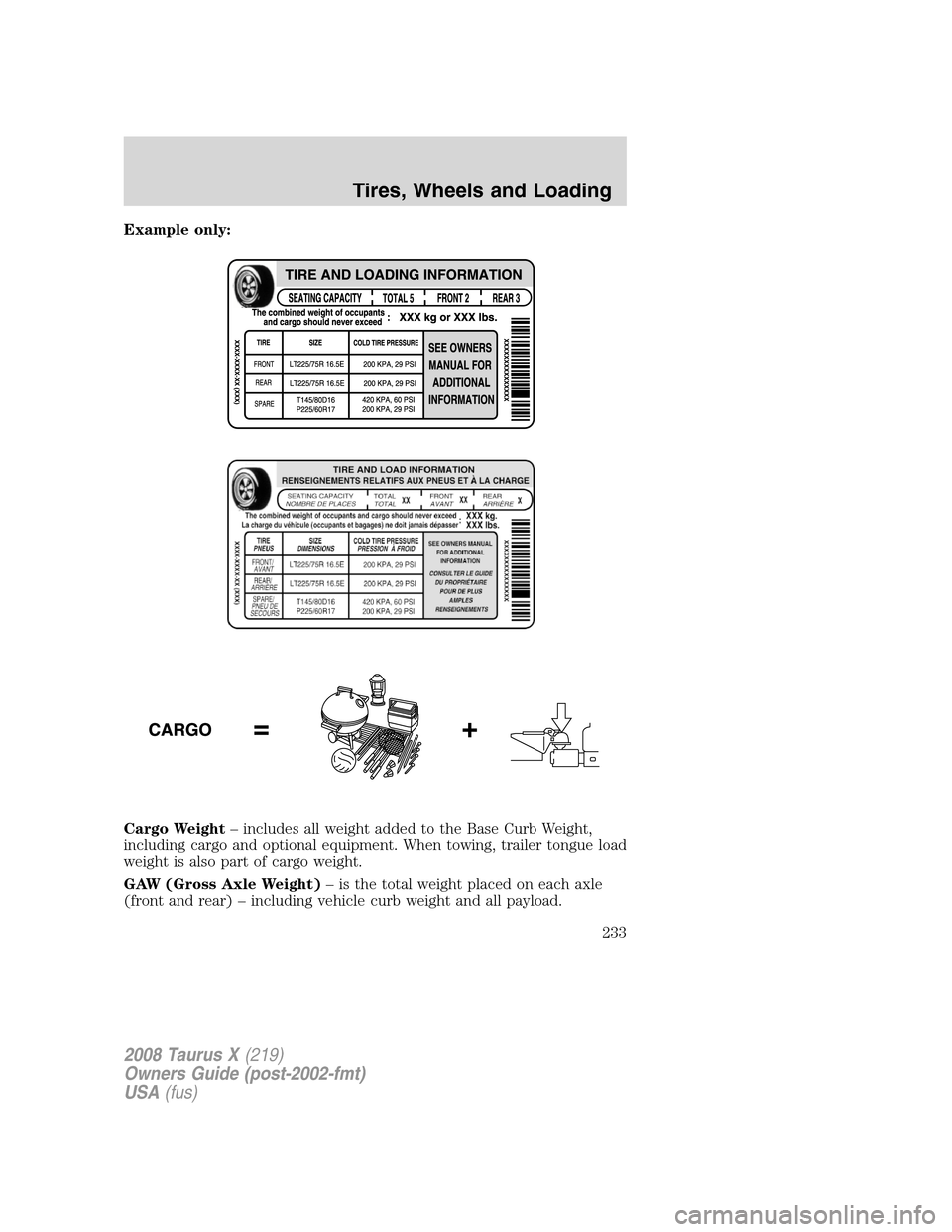
Example only:
Cargo Weight– includes all weight added to the Base Curb Weight,
including cargo and optional equipment. When towing, trailer tongue load
weight is also part of cargo weight.
GAW (Gross Axle Weight)– is the total weight placed on each axle
(front and rear) – including vehicle curb weight and all payload.
2008 Taurus X(219)
Owners Guide (post-2002-fmt)
USA(fus)
Tires, Wheels and Loading
233
Page 234 of 352
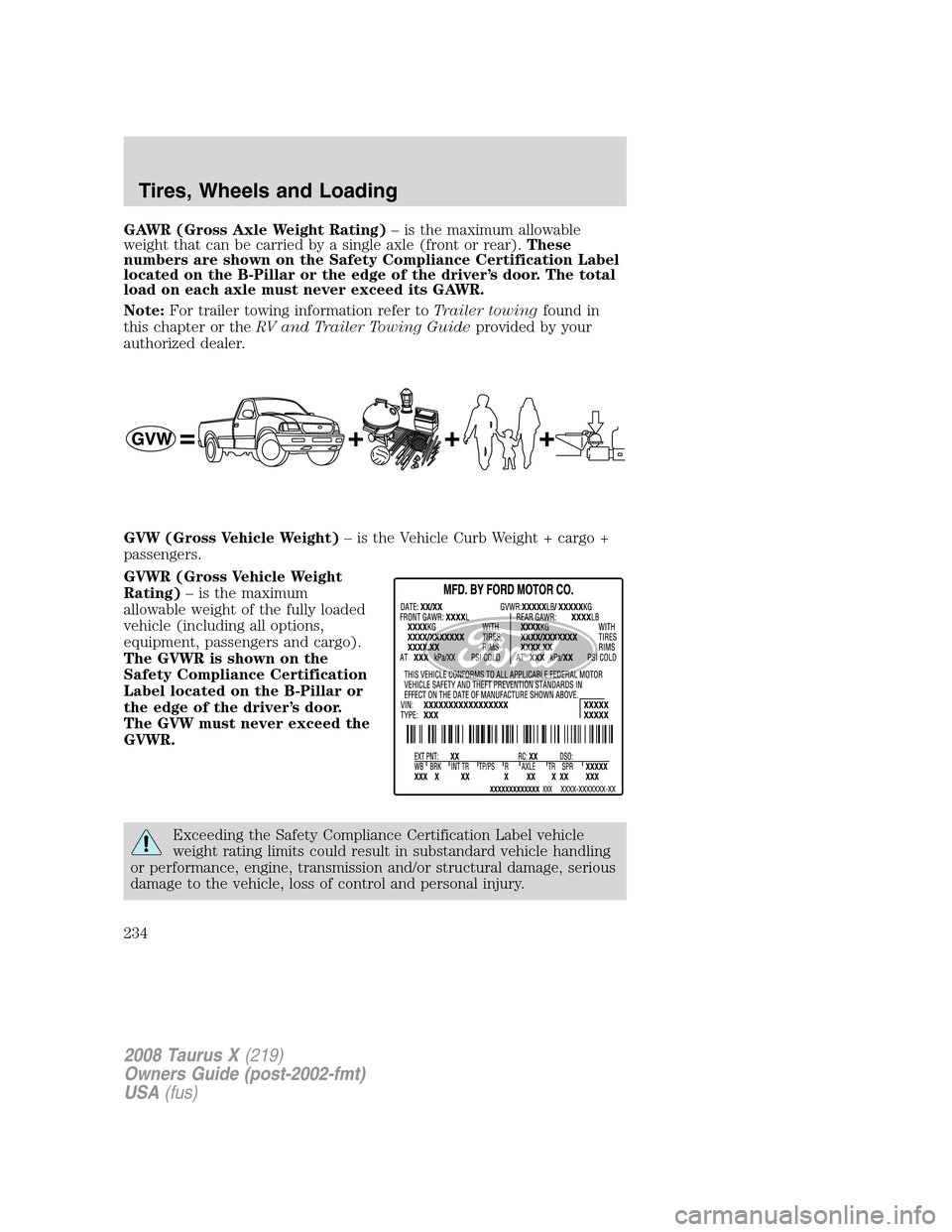
GAWR (Gross Axle Weight Rating)– is the maximum allowable
weight that can be carried by a single axle (front or rear).These
numbers are shown on the Safety Compliance Certification Label
located on the B-Pillar or the edge of the driver’s door. The total
load on each axle must never exceed its GAWR.
Note:For trailer towing information refer toTrailer towingfound in
this chapter or theRV and Trailer Towing Guideprovided by your
authorized dealer.
GVW (Gross Vehicle Weight)– is the Vehicle Curb Weight + cargo +
passengers.
GVWR (Gross Vehicle Weight
Rating)– is the maximum
allowable weight of the fully loaded
vehicle (including all options,
equipment, passengers and cargo).
The GVWR is shown on the
Safety Compliance Certification
Label located on the B-Pillar or
the edge of the driver’s door.
The GVW must never exceed the
GVWR.
Exceeding the Safety Compliance Certification Label vehicle
weight rating limits could result in substandard vehicle handling
or performance, engine, transmission and/or structural damage, serious
damage to the vehicle, loss of control and personal injury.
2008 Taurus X(219)
Owners Guide (post-2002-fmt)
USA(fus)
Tires, Wheels and Loading
234
Page 235 of 352
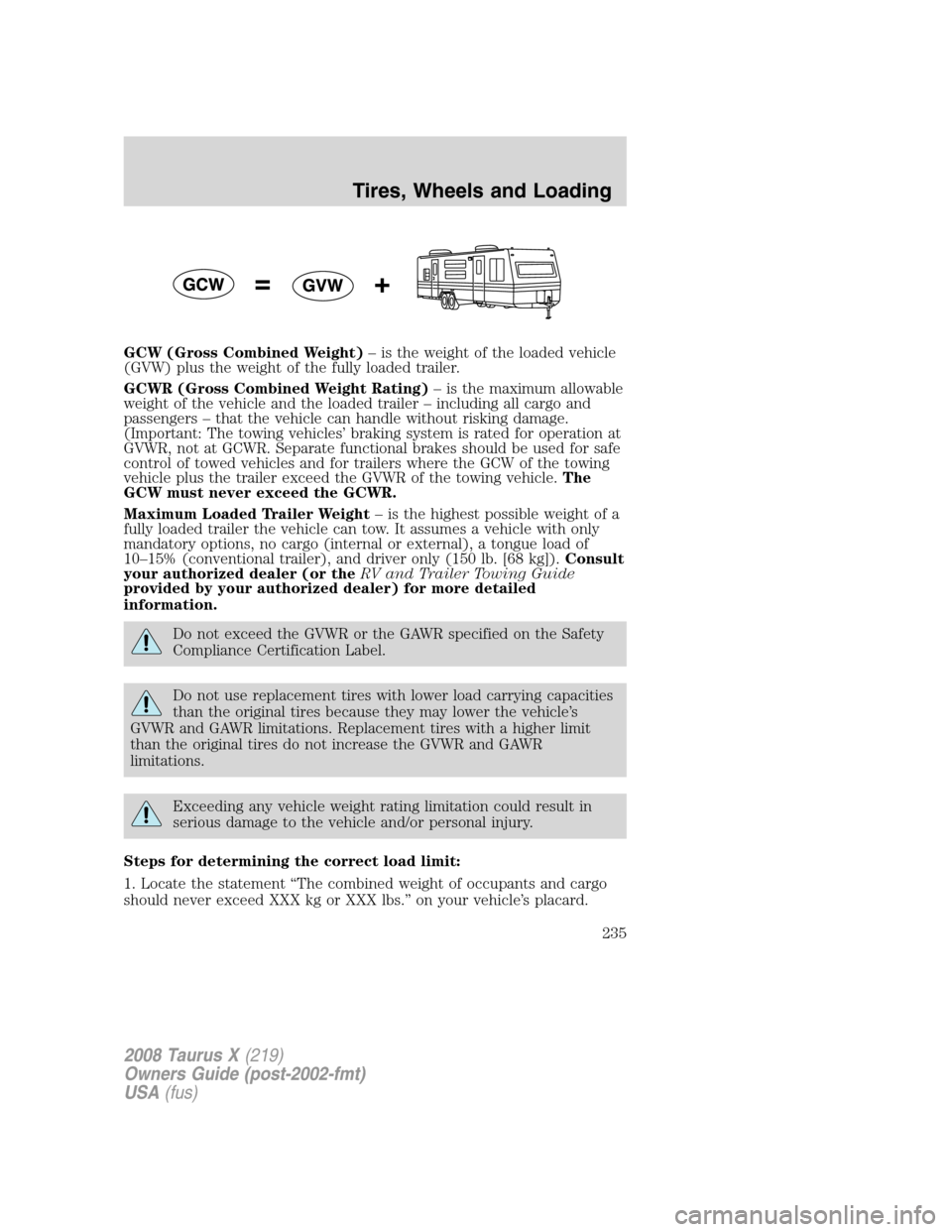
GCW (Gross Combined Weight)– is the weight of the loaded vehicle
(GVW) plus the weight of the fully loaded trailer.
GCWR (Gross Combined Weight Rating)– is the maximum allowable
weight of the vehicle and the loaded trailer – including all cargo and
passengers – that the vehicle can handle without risking damage.
(Important: The towing vehicles’ braking system is rated for operation at
GVWR, not at GCWR. Separate functional brakes should be used for safe
control of towed vehicles and for trailers where the GCW of the towing
vehicle plus the trailer exceed the GVWR of the towing vehicle.The
GCW must never exceed the GCWR.
Maximum Loaded Trailer Weight– is the highest possible weight of a
fully loaded trailer the vehicle can tow. It assumes a vehicle with only
mandatory options, no cargo (internal or external), a tongue load of
10–15% (conventional trailer), and driver only (150 lb. [68 kg]).Consult
your authorized dealer (or theRV and Trailer Towing Guide
provided by your authorized dealer) for more detailed
information.
Do not exceed the GVWR or the GAWR specified on the Safety
Compliance Certification Label.
Do not use replacement tires with lower load carrying capacities
than the original tires because they may lower the vehicle’s
GVWR and GAWR limitations. Replacement tires with a higher limit
than the original tires do not increase the GVWR and GAWR
limitations.
Exceeding any vehicle weight rating limitation could result in
serious damage to the vehicle and/or personal injury.
Steps for determining the correct load limit:
1. Locate the statement “The combined weight of occupants and cargo
should never exceed XXX kg or XXX lbs.” on your vehicle’s placard.
2008 Taurus X(219)
Owners Guide (post-2002-fmt)
USA(fus)
Tires, Wheels and Loading
235
Page 236 of 352

2. Determine the combined weight of the driver and passengers that will
be riding in your vehicle.
3. Subtract the combined weight of the driver and passengers from
XXX kg or XXX lbs.
4. The resulting figure equals the available amount of cargo and luggage
load capacity. For example, if the “XXX” amount equals 1,400 lbs. and
there will be five 150 lb. passengers in your vehicle, the amount of
available cargo and luggage load capacity is 650 lbs. (1400–750 (5 x 150)
= 650 lb.). In metric units (635–340 (5 x 68) = 295 kg.)
5. Determine the combined weight of luggage and cargo being loaded on
the vehicle. That weight may not safely exceed the available cargo and
luggage load capacity calculated in Step 4.
6. If your vehicle will be towing a trailer, load from your trailer will be
transferred to your vehicle. Consult this manual to determine how this
reduces the available cargo and luggage load capacity of your vehicle.
The following gives you a few examples on how to calculate the available
amount of cargo and luggage load capacity:
•
Another example for your vehicle with 1400 lb. (635 kg) of cargo and
luggage capacity. You decide to go golfing. Is there enough load capacity
to carry you, 4 of your friends and all the golf bags? You and four friends
average 220 lb. (99 kg) each and the golf bags weigh approximately 30
lb. (13.5 kg) each. The calculation would be: 1400 - (5 x 220) - (5 x 30)
= 1400 - 1100 - 150 = 150 lb. Yes, you have enough load capacity in your
vehicle to transport four friends and your golf bags. In metric units, the
calculation would be: 635 kg - (5 x 99 kg) - (5 x 13.5 kg) = 635 - 495 -
67.5 = 72.5 kg.
•A final example for your vehicle with 1400 lb. (635 kg) of cargo and
luggage capacity. You and one of your friends decide to pick up cement
from the local home improvement store to finish that patio you have been
planning for the past 2 years. Measuring the inside of the vehicle with the
rear seat folded down, you have room for 12-100 lb. (45 kg) bags of
cement. Do you have enough load capacity to transport the cement to
your home? If you and your friend each weigh 220 lb. (99 kg), the
calculation would be: 1400 - (2 x 220) - (12 x 100) = 1400 - 440 - 1200 =
- 240 lb. No, you do not have enough cargo capacity to carry that much
weight. In metric units, the calculation would be: 635 kg - (2 x 99 kg) -
(12 x 45 kg) = 635 - 198 - 540 = -103 kg. You will need to reduce the load
weight by at least 240 lb. (104 kg). If you remove 3-100 lb. (45 kg)
cement bags, then the load calculation would be:
2008 Taurus X(219)
Owners Guide (post-2002-fmt)
USA(fus)
Tires, Wheels and Loading
236